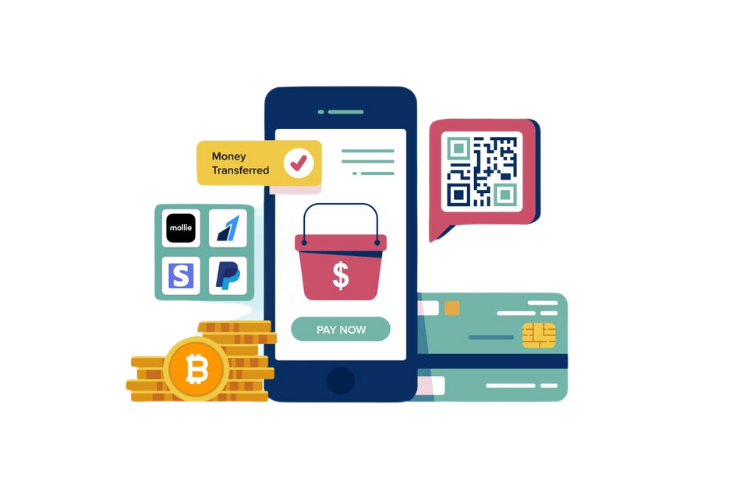Watch video summary
Schedule a Free Consultation Call Today
Discover how we can help you overcome, the latest payment challenges.
Introduction
As e-commerce continues to grow rapidly worldwide, the methods consumers use to pay for goods and services have evolved just as quickly. Businesses are constantly adapting to new payment technologies and customer preferences to remain competitive. However, while the landscape offers numerous opportunities, it also presents challenges that businesses must navigate. In this article, we’ll explore the latest trends in e-commerce payments, the challenges businesses face, and how Facilero can support businesses in managing these changes.
Growing Popularity of Digital Wallets and Contactless Payments
Digital wallets and contactless payments have become an integral part of the e-commerce experience. Consumers are increasingly using services like mobile wallets, allowing for faster, more secure, and frictionless transactions. Digital wallets, such as Apple Pay and Google Wallet, offer a level of convenience that traditional card payments struggle to match. This trend isn’t just limited to smartphones; smartwatches and other wearable devices are also becoming payment tools.
For businesses, adopting digital wallets offers several advantages. By providing secure, one-click checkout experiences, companies can reduce cart abandonment rates, improve customer satisfaction, and encourage repeat purchases. On the flip side, businesses that have yet to integrate these technologies risk falling behind in a highly competitive market.
Buy Now, Pay Later (BNPL) as a Consumer Trend
One of the most significant shifts in e-commerce payments is the rise of the “Buy Now, Pay Later” (BNPL) model. Consumers, especially younger ones, are embracing the flexibility that BNPL offers, allowing them to make purchases upfront and pay for them in installments. BNPL not only gives customers greater purchasing power but also encourages them to make larger transactions.
For e-commerce businesses, offering BNPL as a payment option can lead to increased sales, higher average order values, and improved customer loyalty. However, businesses must also be aware of the challenges, such as the potential for customers to default on payments, which could negatively impact cash flow.
The Challenges of Cross-Border E-Commerce Payments
With e-commerce transcending geographical borders, businesses are increasingly dealing with cross-border transactions. While this opens up new markets, it also comes with its own set of challenges, particularly when it comes to payment methods and currencies. Consumers in different regions have varying preferences for how they want to pay, from credit cards to local payment methods like bank transfers and mobile money.
Cross-border payments also introduce complexities such as currency conversion, differing tax regulations, and additional fees. Businesses must ensure they provide localized payment methods and transparent pricing, or risk alienating potential international customers. Offering localized payment options not only improves the customer experience but also helps businesses build trust in new markets.
The Importance of Fraud Prevention in Digital Payments
As e-commerce grows, so does the risk of fraud. Cybercriminals have become more sophisticated, leveraging tactics such as phishing, account takeovers, and card-not-present (CNP) fraud to target e-commerce businesses. Traditional fraud prevention tools may no longer be sufficient in combating these evolving threats.
This is where AI-powered fraud detection tools come into play. By analyzing transaction data in real-time, AI can detect unusual patterns, flag potentially fraudulent transactions, and take immediate action. This not only protects businesses from financial losses but also maintains a seamless customer experience by minimizing false positives—genuine transactions that are mistakenly flagged as fraud.
Payment Processing Fees and Their Impact on Margins
One of the ongoing challenges for e-commerce businesses is managing payment processing fees. Every transaction comes with a fee that varies depending on the payment method, transaction volume, and region. For small to medium-sized businesses, these fees can significantly impact profit margins, especially when dealing with high transaction volumes.
Moreover, the rise of alternative payment methods such as BNPL or cross-border transactions often comes with additional processing fees, adding to the financial burden. To counter this, businesses must carefully select payment providers that offer competitive fees, transparent pricing, and the flexibility to scale as the business grows.
At the same time, businesses should consider implementing payment strategies that reduce overall costs, such as encouraging customers to use lower-cost payment methods or optimizing checkout processes to avoid failed transactions.

Integration Complexities in E-commerce Payment Systems
In the rapidly evolving e-commerce landscape, businesses are often required to integrate new payment technologies with their existing systems. However, this can present significant challenges. Seamlessly integrating a new payment gateway or digital wallet system requires technical expertise, and any disruption in the payment process can lead to lost sales and frustrated customers.
Businesses need to invest in platforms that offer easy-to-integrate payment solutions, allowing for smooth transitions without impacting the overall customer experience. This also includes ensuring that the payment systems are compatible with both mobile and desktop devices, as consumers increasingly shop across multiple channels.
The Future of E-commerce Payments
Looking ahead, the future of e-commerce payments is set to be defined by further innovations in technology and consumer behavior. AI, blockchain (without referencing competitors), and biometrics are likely to play larger roles in shaping how businesses accept and process payments. The integration of AI into fraud prevention and customer personalization will continue to improve security and optimize the checkout process.
Furthermore, the adoption of real-time payments will increase as consumers demand faster transaction times. These instant payment options, which allow funds to be transferred between accounts in real time, could revolutionize how businesses manage their cash flow and enhance the customer experience.
Conclusion
In the dynamic world of e-commerce, payment trends are evolving as rapidly as consumer expectations. From the growing dominance of digital wallets to the complexities of cross-border transactions, businesses must stay ahead of these changes to remain competitive. While the adoption of new payment technologies offers opportunities for growth, it also presents challenges in the form of integration, fees, and fraud prevention.
How Facilero Can Help You?
When it comes to payment solutions, businesses today need flexibility, security, and scalability. The digital payments landscape is evolving rapidly, and the challenges of adapting to new technologies, regulatory requirements, and consumer expectations can be daunting. At Facilero, we understand that every business has unique needs, and we’re here to support you in navigating these complexities.
Whether you’re dealing with cross-border transactions, looking to streamline your e-commerce payments, or seeking to enhance fraud prevention, partnering with a payment provider who stays ahead of industry trends is crucial. Our goal is to ensure that your payment systems not only meet today’s demands but are also adaptable for future growth.
We don’t just offer solutions; we build strategies tailored to help your business succeed in an increasingly competitive marketplace. With an emphasis on transparency, security, and user-friendly payment processes, we’re dedicated to helping your company operate smoothly and efficiently.
Contact us now and let us help take your business to the next level!
Get A Free Consultation
Book a free call with us to discuss how we can help you expand in new regions, scale, and get the cash flowing in your business.





